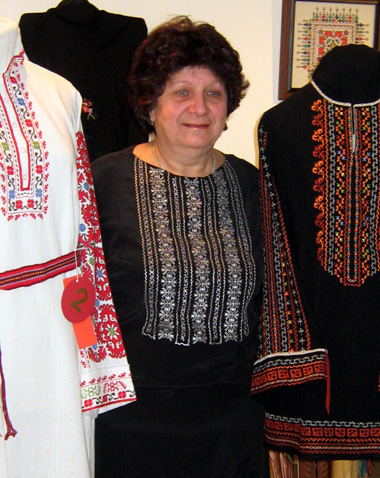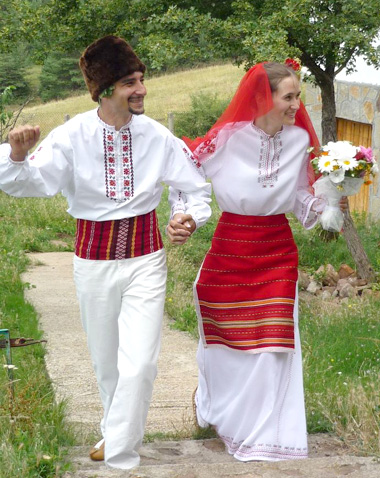It all begins with a needle, a colour thread and fabric. And amazing embroidery is born of the nimble fingers of the master-embroidress. Antoaneta  Toltouokova was born and lives in Sofia, but she is an economist by profession. She works as an accountant but has one passion – embroidery. She says that she has used needles in all of their varieties for as long as she can remember. She can knit using one and five knitting-needles, but what she loves most is working with an ordinary needle with an eye. With the help of a needle and thread she makes colour and white embroidery. Her great love is traditional Bulgarian embroidery. Since 1984 Antoaneta has been a master-embroider at the Society of Traditional Arts and Crafts and has taken part in exhibitions all over the world. She is also founder of a group that has dedicated its efforts to preserving national tradition – the Sedyanka (working-bee) workshop.
Toltouokova was born and lives in Sofia, but she is an economist by profession. She works as an accountant but has one passion – embroidery. She says that she has used needles in all of their varieties for as long as she can remember. She can knit using one and five knitting-needles, but what she loves most is working with an ordinary needle with an eye. With the help of a needle and thread she makes colour and white embroidery. Her great love is traditional Bulgarian embroidery. Since 1984 Antoaneta has been a master-embroider at the Society of Traditional Arts and Crafts and has taken part in exhibitions all over the world. She is also founder of a group that has dedicated its efforts to preserving national tradition – the Sedyanka (working-bee) workshop.
 “The idea was to bring together people with certain skills in making different everyday objects, connected with Bulgarian tradition – such as embroidery, crochet and knit-work so that we may keep these skills alive and popularize them. Otherwise they slowly die out. These are things that are not learnt at school or in the family. There are girls who cannot sew on a button, let alone anything more difficult. And that is what our efforts aim at – to popularize the skills of Bulgarian women. In the past they used to make all clothes for the whole family. Starting with the growing of the flax or hemp, weaving the fabric and ending with the decorations – this wonderful embroidery. There are couples who want an ethno-style wedding in traditional costumes. I myself have made several costumes like this – for the bride and for the bridegroom. I always endeavour to achieve something that resembles the authentic costumes as closely as possible. Embroidery has a magic of its own and there are things that are unique. Last year I made two shirts for a young family who had wanted children for a long time. And I am happy to say they are now expecting their first baby. Of course, there is an explanation connected with psychology here, but I would still like to believe there is magic as well. Embroideries can be applied to all kinds of accessories like brooches, earrings, jewelry, martenitsas and Christmas tree decorations, key rings. There are many things that can be made, all it takes is a little imagination. Embroideries are by no means outdated. They are a wonderful thing, a treasure-trove passed down to us by our mothers and grandmothers, something we must preserve. Unfortunately, the fabric and the thread are perishable commodities, so if we don’t continue making embroidery, the skill will be lost.”
“The idea was to bring together people with certain skills in making different everyday objects, connected with Bulgarian tradition – such as embroidery, crochet and knit-work so that we may keep these skills alive and popularize them. Otherwise they slowly die out. These are things that are not learnt at school or in the family. There are girls who cannot sew on a button, let alone anything more difficult. And that is what our efforts aim at – to popularize the skills of Bulgarian women. In the past they used to make all clothes for the whole family. Starting with the growing of the flax or hemp, weaving the fabric and ending with the decorations – this wonderful embroidery. There are couples who want an ethno-style wedding in traditional costumes. I myself have made several costumes like this – for the bride and for the bridegroom. I always endeavour to achieve something that resembles the authentic costumes as closely as possible. Embroidery has a magic of its own and there are things that are unique. Last year I made two shirts for a young family who had wanted children for a long time. And I am happy to say they are now expecting their first baby. Of course, there is an explanation connected with psychology here, but I would still like to believe there is magic as well. Embroideries can be applied to all kinds of accessories like brooches, earrings, jewelry, martenitsas and Christmas tree decorations, key rings. There are many things that can be made, all it takes is a little imagination. Embroideries are by no means outdated. They are a wonderful thing, a treasure-trove passed down to us by our mothers and grandmothers, something we must preserve. Unfortunately, the fabric and the thread are perishable commodities, so if we don’t continue making embroidery, the skill will be lost.”
Antoaneta Toltoukova says that people used to believe embroideries protected and shielded the person who put them on – from evil eyes, from diseases. It was believed that snakes and other kinds of vermin, when they see their semblance on shirts and other clothing will run for their lives. “Embroideries have always developed parallel with the way of life, they have always been an integral part of daily routine. Our lives today are very different from the lives of our grandmothers, so we are out to find a more modern application for embroidery. I use ready-made blouses and other items of clothing which I embroider, and that makes them ready for everyday wear,” she says and adds:
 “To me embroidery is a veritable compulsion. If I am unable to embroider, I dream and think of embroidery. To my mind, besides my family, embroidery is the best thing that ever happened to me. Unfortunately I have no followers because I have two sons and four grandsons, while my daughter is keen on knitting. My family support me and never grumble that I am neglecting them, needles in hand. My husband accompanies me to all exhibitions I take part in, and I take part in quite a few. Works of mine have traveled the world. To Australia, USA, Europe, and as far I know Africa. Unfortunately, years ago there were many more exhibitions of this craft - the Society of Traditional Arts and Crafts used to arrange expositions in Bulgaria and abroad. Now exhibitions are on mostly at the Ethnographic Museum in Sofia.”
“To me embroidery is a veritable compulsion. If I am unable to embroider, I dream and think of embroidery. To my mind, besides my family, embroidery is the best thing that ever happened to me. Unfortunately I have no followers because I have two sons and four grandsons, while my daughter is keen on knitting. My family support me and never grumble that I am neglecting them, needles in hand. My husband accompanies me to all exhibitions I take part in, and I take part in quite a few. Works of mine have traveled the world. To Australia, USA, Europe, and as far I know Africa. Unfortunately, years ago there were many more exhibitions of this craft - the Society of Traditional Arts and Crafts used to arrange expositions in Bulgaria and abroad. Now exhibitions are on mostly at the Ethnographic Museum in Sofia.”
Embroidery has a life and a future, Antoaneta says – she has seen with her own eyes how the Sedyanka workshop has been expanding. It now has male members, whose hobby is embroidery and tapestry making - the colour threads have cast their spell over men too. One example is 20-year old Alexander, who makes embroidered towels. Another young man collects embroidered traditional costumes and tapestries.
English version: Milena Daynova
Folk costumes and customs from across the country will be presented at the Kostina Historical Site in Ribaritsa village. The event will take place on 19 and 20 July as part of the Holiday of Folk Customs and Authentic Costumes . According to the..
Everyone in Bulgaria has heard scary stories about dangerous vampires since childhood. Today, these dark spirits are familiar to us mainly from the way they are recreated by the authors of novels and especially popular titles in the cinema. However, we..
A festive concert of the Otets Paissii Performing Folk Ensemble will be held in Nessebar today, as the ensemble celebrates 70 years since its establishment. The formation is the oldest Bulgarian folklore ensemble in the USA at the..

+359 2 9336 661
